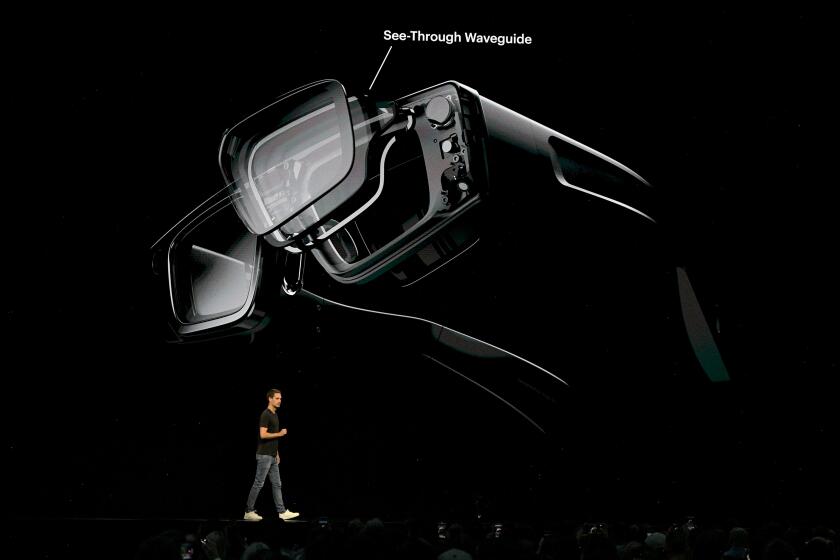Wearing a computer on your face? Snap looks to take on rivals with new augmented reality glasses

- Share via
For years, Snap has envisioned a future where people wear glasses to view and interact with computer-generated images without having to scroll through their smartphones.
The Santa Monica-based tech company will soon see if its multibillion-dollar bet on augmented reality glasses has paid off.
Snap said Tuesday it plans to release in 2026 AR glasses that people will be able to buy.
Last year, Snap launched the latest version of its AR glasses, but the gadget was only available to developers. The new AR glasses, known as Specs, will be lighter and more advanced than what was shown in 2024, Snap said.
The company behind the disappearing messaging app Snapchat hasn’t revealed the price of the glasses or exactly when they will go on sale.
Augmented reality involves overlaying digital objects onto a person’s view of the physical world, allowing people to wear virtual dog ears on their faces and catch virtual Pokémon. Snap says its glasses will be useful in more ways, helping people translate signs, learn how to play the drums, browse recipes and access AI assistance.
Tech giants including Meta, Snap, Google and others are racing to build smart glasses. It could change our lives for the better or worse.
“We’re obsessed with making computers more human. And with advances in AI, computers are thinking and acting like humans more than ever before. But if we want to unleash the true potential of AI, we need to bring it from screens into the real world,” said Evan Spiegel, Snap’s co-founder and chief executive, in his prepared remarks for the Augmented World Expo. The conference, held in Long Beach, focuses on technology such as AR.
Snap is betting big that AR glasses will reshape how people interact with technology, spending more than $3 billion and 11 years building AR glasses. The competition has been fierce.
Snap’s announcement comes as major tech companies including Meta, Google and Apple also work on glasses with AI-powered tools.
Ben Bajarin, chief executive and principal analyst at Creative Strategies, a market research firm in San Jose, said it’s hard for Snap to compete with major tech companies like Google, Meta and OpenAI that have a lot of valuable data that power their AI tools.
“It’s not just the ability to do AR and display. It’s also this multimodal AI engine that ties to cameras and you can interact with it, ” he said.
Even if Snap’s rivals release glasses that don’t display virtual images on top of the physical world, consumers will likely be hesitant to spend more money on extra features.
“If they get the price point down and they become more fun, more whimsical, then they compete on a different vector than what Google and OpenAI and probably Meta are going to try to do,” he said.
While tech companies have released glasses in the past, convincing people to buy them has been an uphill battle. Early versions of Snap’s Spectacles, used for recording videos, and smartglasses such as Google Glass flopped but technology has improved.
President Trump’s on-again, off-again tariffs on goods from countries such as China could also impact the development of new gadgets or consumer appetite to buy new electronics.
Still, tech companies have signaled they’re not ready to give up on building glasses. Meta and Ray-Ban sell smartglasses that let people capture photos and videos, listen to music and interact with an AI assistant. The social media giant also unveiled more capable AR glasses, known as Orion, but they aren’t available for the public to buy.
This year, Google showcased a prototype of its glasses at its developer conference. Paired with a smartphone, people donning the glasses can find more information about a painting or travel by asking its AI assistant, Gemini, a question out loud.
OpenAI, the maker behind ChatGPT, teamed up with Jony Ive — a former Apple executive who helped design the iPhone — to work on a new AI-powered device, but hasn’t revealed what it is.
AR glasses also give Snap another way to make money outside of digital ad sales. In April, Snap’s stock fell more than 15% after the company held back its forecast for the second quarter, sparking concerns that economic uncertainty around Trump’s tariffs could prompt advertisers to pull back spending. As of Tuesday, Snap’s stock has been down more than 24% so far this year at $8.49 per share.
The company has grown its revenue while reducing its net losses. Snap’s first quarter revenue grew 14% from $1.19 billion in 2024 to $1.36 billion this year. The company’s net loss dropped 54% to $140 million.
Snap has more than 900 million monthly active users and 460 million daily active users.
More to Read
Inside the business of entertainment
The Wide Shot brings you news, analysis and insights on everything from streaming wars to production — and what it all means for the future.
You may occasionally receive promotional content from the Los Angeles Times.












